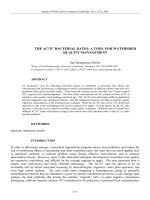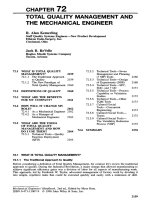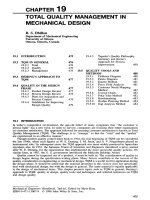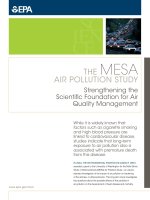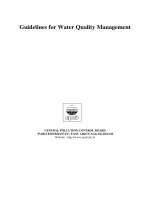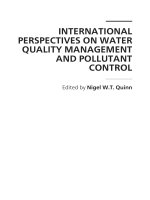construction quality management - s. tang, et al., (hong kong univ. press, 2005)
Bạn đang xem bản rút gọn của tài liệu. Xem và tải ngay bản đầy đủ của tài liệu tại đây (20.79 MB, 209 trang )
@Q)K!©M<1CTI®K1
MMJOT
smimciiMiKnr
S.L. Tang
Syed M. Ahmed
Raymond T. Aoieong
S.W. Poon
CONSTRUCTION
QUALITY
MANAGEMENT CONSTRUCTION
QUALITY
MANAGEMENT
S.L. Tang
Syed M. Ahmed
Raymond T. Aoieong
S.W. Poon
# m * * & «L *t
HONG KONG UNIVERSITY PRESS
Hong Kong University Press
14/F Hing Wai Centre
7 Tin Wan Praya Road
Aberdeen
Hong Kong
© Hong Kong University Press 2005
ISBN 962 209 746 4
All rights reserved. No part of this publication may be
reproduced or transmitted, in any form or by any means,
electronic or mechanical, including photocopy, recording,
or any information storage or retrieval system, without prior
permission in writing from the publisher.
British Library Cataloguing-in-Publication Data
A catalogue record for this book is available from the British Library.
Secure On-line Ordering
Printed and bound by Condor Production Co. Ltd., Hong Kong, China
CONTENTS
Preface vii
Chapter 1: Introduction to construction quality management 1
Chapter 2: Quality management and ISO 9000 Standard 15
Chapter 3: Development of construction quality management 29
in Hong Kong and other countires
Chapter 4: Implementation of quality management systems 39
by Hong Kong contractors and consultants
Chapter 5: Quality indicators 55
Chapter 6: Quality audits 69
Chapter 7: Total quality management (TQM) in the construction industry 81
Chapter 8: Transition from ISO 9000:1994 to ISO 9000:2000 105
and integration of QMS with TQM philosophy
Chapter 9: Quality cost measurement I (prevention, appraisal 121
and failure costs model)
Hf CONTENTS
Chapter 10: Quality cost measurement II (process cost model) 141
Chapter 11: Applications of CPCM (Construction Process Cost Model) 159
Chapter 12: Developing a quality culture as the way forward 185
About the Authors 197
PREFACE
The first Quality Assurance Standard, BS 5750, was published in 1979 and
the International Organisation for Standardisation used it as the basis for
the ISO 9000 standard published in 1987. Over the decade that had passed
since BS 5750 (i.e. the 1980s), other industry sectors, particularly the
manufacturing sector, had begun to implement these management tools,
while there was no apparent interest within the Hong Kong construction
industry.
In the 1970s and 1980s, the construction industry in Hong Kong generally
adopted the quality control (QC) practice to maintain the standard of
construction products. In 1987, the Hong Kong Housing Authority (HKHA)
encouraged two major local pre-cast spun concrete pile manufacturers to
develop quality management schemes based on the above-said ISO 9000
standard for their products, and hence discovered and began to understand
the potential benefits of quality assurance (QA) systems for guaranteeing
quality at source. Under the quality surveillance of the manufacturing of
concrete piles, it was observed that the quality management schemes
provided a high measure of quality assurance for construction processes.
Due to the experience gained by HKHA, the Works Bureau of Hong Kong,
which undertakes all public civil engineering works in the territory, began
to follow HKHA to use the same kind of quality management systems since
the 1990s for ensuring the quality of their construction products.
The purpose of this book is to examine the development of quality management
systems applied to the construction industry in Hong Kong and other parts of
the world. The main emphasis, of course, is based on Hong Kong experience,
because at present Hong Kong plays a leading role in construction quality
management in the world. Readers will understand how QC (quality control)
practice was replaced by QA (quality assurance) concept, and then how the
QA concept is being superseded by the TQM (total quality management)
philosophy. All the tools and techniques used which are related to construction
quality management are discussed in detail throughout the 12 chapters in this
book.
Chapter 1 introduces the idea of construction quality management, with
definitions relevant terms and an explanation of the differences between QC,
QA and TQM. Chapter 2 traces the development of the ISO 9000 standard and
highlights the differences between the version in 1994 and that in 2000. In the
same chapter, an introduction to quality management systems adopted by
construction organizations based on the ISO 9000 standard is also given. Chapter
3 provides a general description of the development and implementation of
construction quality management in Hong Kong and other parts of the world,
such as Singapore, the UK, the USA, and so on. In Chapter 4, the experience of
construction quality management implementation in Hong Kong is discussed
in detail. The merits and demerits of implementing such systems experienced
by Hong Kong contracting and consulting firms are fully reported in the same
chapter.
Chapter 5 introduces what quality indicators, such as CONQUAS and PASS,
are.
Quality indicators are used to measure the quality of finished products of
construction
works.
Chapter 6 goes on to discuss what quality audits
are.
Quality
audits are used to measure the effectiveness of quality management systems
adopted and implemented by construction organizations. Therefore, quality
indicators and quality audits serve different purposes, and they are fully
discussed in these two chapters. As TQM is a further step of
QA
implementation,
Chapter 7 examines TQM in detail, although it has been generally introduced
in Chapter 1. Usually, QA serves as a stepping stone to TQM, the latter being
the ultimate goal of quality management. Therefore, after the full account of
TQM in Chapter 7, Chapter 8 goes on to describe the Hong Kong construction
organizations' experience in transitioning from QA to TQM in their quality
management systems, or integrating their quality management systems with
the TQM philosophy.
In order to quantify the benefits arise from implementing quality management
systems, quality costs must be measurable. In Chapter 9, the definitions of
quality costs and the methods of measuring them are given. In the same chapter,
the traditional PAF (prevention, appraisal and failure) cost model is described.
There are disadvantages in using the PAF model for measuring quality costs of
construction
works.
Chapter 10 proposes an alternative model to the PAF model,
called the PCM (process cost model). It has several advantages over the
traditional PAF model, and these are discussed in detail in the same chapter.
Chapter 11 reports two case studies using the CPCM (construction process
cost model) to capture construction quality costs. It can be seen that CPCM is
more in line with TQM philosophy and is easy to apply in the construction
industry. In Chapter 12, the last chapter, the authors present their personal
views on the future development of construction quality management. Some
salient ideas, such as quality culture and cultural audits, are thrown out in the
chapter. The book ends with a diagram relating several very important aspects
of construction quality management: CPCM, quality culture, continual
improvement, quality management system and TQM.
As a comprehensive volume covering all the important topics on construction
quality management and their latest development, this is a valuable reference
book for construction professionals, and is also suitable as a text book for
university undergraduate and postgraduate courses in construction management
or quality management.
4fi
iNTOopticrri^^fTlo
TONSTRCH
CTIODTi
AGEMENT
Quality is widely accepted as one of the key factors for companies to be
successful in the global market. Quality management has been an important
issue for many years in various disciplines. The implementation of effective
quality management has been witnessed and documented in the
manufacturing industry, which set up a paradigm for other disciplines such
as the design and construction industry In the past few years, things have
changed in the construction sector. It has opened its doors by welcoming
policies that would improve construction process and lead to successful
business strategies. Effective quality management, especially total quality
management (TQM), has been recognized as an enabler for performance
improvement in the construction industry.
1.1 An Introduction to Quality
Quality can be defined as a state that meets the legal, aesthetic and functional
requirement of a product or project by customers. Requirements may be
simple or complex, or they may be stated in terms of the result required or as
a detailed description of what is to be done. Metrology, specifications,
inspection all go back many centuries before the Christian era. Following
the Second World War, two major forces emerged that have had a profound
CONSTRUCTION QUALITY MANAGEMENT
impact
on
quality:
(1) the
Japanese revolution
in
quality;
and (2) the
prominence
of
product quality
in the
public mind. During
the
twentieth
century,
a
significant body
of
knowledge
on
achieving superior quality
emerged, advanced by Juran, Deming, Feigenbaum, Crosby
and
Ishikawa.
Here
are
some examples
of
defining quality.
"Providing customers with products and services that consistently meet
their needs
and
expectations" — Boeing
"Meeting the customer's need the first time and every time"
Services Administration, US Government
General
"Performance
to
the standard expected by
the
customer"
—
FEDEX
"Doing
the
right thing right
the
first time, always striving
for
improvement,
and
always satisfying
the
customer"
—
US Department
of Defense
From the above examples, quality has the following common characteristics:
1.
It
involves meeting
or
exceeding customer expectations.
2.
It
applies
to
products, services, people, processes,
and
environments.
3.
It is an
ever-changing state (i.e., what
is
considered quality today may
not be good enough
to be
considered quality tomorrow).
Quality
is
a dynamic state associated with products, services, people, processes
and environments that meets
or
exceeds expectations. Quality
is
always
related
to
customer satisfaction/loyalty and the fitness
of
use
is
designed
for
end customers. Figure
1.1
gives
a
detailed look into
the
customer structure
of a manufacturing company.
External Customer
- Ultimate users, intermediate
processors
and
menrchants
- Having some connection
to
the product
- They
are of
primary
imortance
Stake Holders
Internal Customer
- Other division
of
a company
- Departments
or
persons that
supply products
to
each
other
Goods-automobbiles
Product-"It is the output of any process'
1
Software-computer program
Service-banking
Figure 1.1 Customer structure of a manufacturing company
INTRODUCTION
TO
CONSTRUCTION QUALITY MANAGEMENT
3
The Relationship of Quality with Productivity, Costs, Cycle
Time and Value
1 Quality and Productivity
^
j
Saleable output
•
Productivity
=
£
——
Resources used
• Improvement
in
quality directly results
in an
increase
in
productivity.
2 Quality and Costs
•
As the
quality
of
design increases, cost increases.
•
As the
quality
of
conformance increases, cost decreases.
3 Quality and Cycle Time
•
The
cycle time
to
complete
the
activities
is the
key parameter.
• Quality improvement efforts will reduce cycle time.
4 Quality and Value
• Value = Quality/ Price
• Organizations must evaluate
the
value they provide, relative
to the
competition.
Quality Management
Quality management
is the
process
of
identifying
and
administering
the
activities needed
to
achieve
the
quality objectives
of an
organization.
Useful
way of
introducing
qualiy management
DDI=>
Relate
it to
another
well-
known management
concept (financial)
Figure
1.2
Diagram
of
quality management
Quality management
is
defined
as
(BS EN ISO 8402):
"All activities
of
the overall management function that determine
the quality policy, objectives
and
responsibilities,
and
implement
CONSTRUCTION QUALITY MANAGEMENT
them by means such as quality planning, quality control, quality
assurance, and quality improvement within the quality system."
Total Quality Management
• Policy deployment
• Invoive suppliers and customers
• Invoive all operations
• Process management
• Performance measurement
• Teamwork
• Employee involvement
Continuous improvement
Empowering people
Caring for people
Involvement
Compliance to specification
Allocating blame
Quality assurance
» Quality systems development
» Advanced quality planning
» Comprehensive quality manuals
» Use of quality costs
» Invoivement of non-production
operations
» Failure mode and effects analysis
» Statistical process control
t
Quality control
• Develop quality manual
» Process performance data
• Self-inspection
» Product testing
» Basic quality planning
» Use of basic statistics
• Paperwork controls
t
Inspection
» Salvage
» Sorting, grading, reblending
• Corrective actions
» Identify sources of
non-
conformance
Figure 1.3 The four stages of quality management
The four stages of quality management are shown in the Figure 1.3. Inspection
and QC are retrospective; they operate in a detection mode, aiming to find
problems that have
occurred
(fire fighting). QA and TQM aim to reduce and
ultimately to avoid problems occurring; they can be used to bring about
improvement (fire prevention).
1.4 Terminology
Some important terms for quality management are as follows:
INTRODUCTION TO CONSTRUCTION QUALITY MANAGEMENT
Quality
ISO 8402 defines quality as the degree of excellence in a competitive sense,
such as reliability, serviceability, maintainability or even individual
characteristics.
Quality Control
Both ANSI and ISO define quality control as the operational technique and
activity to control and measure the characteristics of a material, structure,
component, or system that are used to fulfill requirements for quality.
Quality Systems
Quality systems refer to the organizational structure, procedures, processes
and resources needed to implement quality management.
Quality
Assurance
Quality assurance is the implementation of planned and systematic activities
within quality systems to demonstrate and provide adequate confidence that
an entity will fulfill requirements for quality.
Quality Management
Quality management refers to all activities of overall management functions,
especially top management leadership, that determine quality policy
objectives and responsibilities for all members of the organization.
Total Quality Management
Total quality management is the management approach of an organization,
which is based on the participation of its members, concentrates on quality
and aims at achieving long-term success through satisfaction and benefits to
all members of the organization and society (ISO 8402 and Griffin 1990).
Sometimes, "quality systems" and "quality management" together are
described as "quality management systems'. These terms will be used in the
rest of this chapter and in the other chapters of this book.
» 6 CONSTRUCTION QUALITY MANAGEMENT
1.5 Quality Evolution
There are five stages in the evolution of quality control, as defined by Rounds
and Chi (1984) and Feigenbuam (1991).
• Craftsman quality control was inherent in manufacturing up to the end
of the nineteenth century. At that time, a very small number of craftsmen
were responsible for the manufacturing of
a
complete product and each
craftsman exclusively controlled the quality of his work.
• Foreman quality control occurred during the industrial revolution when
large-scale modern factory concept developed. During this stage, many
craftsmen performing similar tasks were grouped together and supervised
by a foreman, who then assumed responsibility for the quality of their
work.
• Inspection quality control evolved during the First World War when
the manufacturing systems became more complex. Because a large
number of craftsmen reported to a production foreman, full-time
inspectors were required. This era peaked in large organizations in the
1920s and 1930s.
• Statistical quality control flourished during the Second World War when
tremendous mass production was necessary. In effect, this step was a
refinement of the inspection step and resulted in making the large
inspection organizations more efficient. Inspectors were provided with
statistical tools such as sampling and control charts. W.A. Shewhart
developed a statistical chart for the control of product variables in 1924,
marking the beginning of statistical quality control. Later in the same
decade, H.F. Hodge and H.G. Roming developed the concept of
acceptance sampling as a substitute for 100% inspection; this was
considered the most significant contribution of statistical quality control.
• Total quality control evolves in the early 1960s in a four-phase process.
A dramatic increase in user quality requirements resulted in increasing
customer demand for higher-quality products, forcing the manufacturer
to recognize the inadequacy of existing in-plant quality practices and
techniques. All these contributed to excessive quality cost, due to such
items as inspection, testing, laboratory checks, scrapping and reworking
imperfect products, and customer dissatisfaction. These problems
highlighted the dual quality challenge: providing significant
improvement in the quality of products and practices while, at the same
INTRODUCTION TO CONSTRUCTION QUALITY MANAGEMENT 7
time,
effecting substantial reductions in the overall cost of maintaining
quality. Statistical quality control could never meet the challenge; thus,
a totally new concept was developed based upon the principle that in
order to provide genuine effectiveness, control must start with the design
of the product and end only when the product has been placed in the
hands of a customer who remains satisfied (Feigenbuam 1991).
1.6 Pioneers of the Total Quality Movement
Total quality is not just one individual concept. It is a number of related
concepts pulled together to create a comprehensive approach to doing
business (Goetsch and Davis 2003). The major contributors to this concept
are W. Edwards Deming, Joseph M. Juran, Philip B. Crosby and Kaoru
Ishikawa.
1.6.1 Deming
W. Edwards Deming of the United States is considered the father of the
quality movement. He is widely known for the Deming Cycle, his Fourteen
Points, and the Seven Deadly Diseases.
The Deming Cycle
The basic premise of Deming's cycle covers concepts that apply to all
organizations (eCommerce-Now 2001):
1.
Plan: How are you going to look at the problem?
2.
Do: Carry out the research.
3.
Check: Review the results, and see if it achieves what you were
aiming to do; if not, go back to step one.
4.
Act: Decide that something needs to be altered in your work place,
and make a decision to bring about an improvement.
Deming's "plan-do-check-act" cycle will be further discussed in Chapter 7
in detail.
Deming's Fourteen Points
The 14 points are a basis for the transformation of (American) industry.
Adoption and action on the 14 points are a signal that management intends
to stay in business and aim to protect investors and jobs (Deming 1982,
1986).
•I CONSTRUCTION QUALITY MANAGEMENT
1.
Create constancy of purpose toward improvement of product and
service, with the aim to become competitive and to stay in business,
and to provide jobs.
2.
Adopt the new philosophy. In a new economic age, management
must rise to the challenge, learn their responsibilities, and take
on leadership for change.
3.
Cease dependence on inspection to achieve quality. Eliminate the
need for inspection on a mass basis by building quality into the
product in the first place.
4.
End the practice of awarding business on the basis of price tag.
Instead, minimize total cost. Move towards a single supplier for
any one item, on a long-term relationship of loyalty and trust.
5.
Improve constantly and forever the system of production and
service, to improve quality and productivity, and thus constantly
decrease costs.
6. Institute training on the job.
7.
Institute leadership. The aim of supervision should be to help
people and machines and gadgets to do a better
job.
Supervision
of management is in need of an overhaul, as well as supervision of
production workers.
8. Drive out fear, so that everyone may work effectively for the
company.
9. Break down barriers between departments. People in research,
design, sales, and production must work as a team, to foresee
problems of production and problems that may be encountered
when using the product or service.
10.
Eliminate slogans, exhortations, and targets for the workforce
asking for zero defects and new levels of productivity. Such
exhortations only create adversarial relationships, as the bulk of
the causes of low quality and low productivity belong to the system
and thus lie beyond the power of the workforce.
11.
a. Eliminate work standards (quotas) on the factory floor.
Substitute with leadership.
b.
Eliminate management by objective. Eliminate management
by numbers, numerical goals. Substitute with leadership.
12.
Remove barriers that rob the hourly paid worker of his right to
pride in workmanship.
13.
Institute a vigorous programme of education and
self-
improvement.
INTRODUCTION TO CONSTRUCTION QUALITY MANAGEMENT 9
14.
Put everybody in the company to work to accomplish the
transformation. The transformation is everybody's job.
Deming's Seven Deadly Diseases
1.
Lack of constancy of purpose
2.
Emphasis on short-term profits
3.
Evaluation by performance, merit rating, or annual review of
performance
4.
Mobility of management
5.
Running a company on visible figures alone
6. Excessive medical costs
7.
Excessive costs of warranty, fueled by lawyers that work on
contingency fee
1.6.2 Pareto
In 1906, Italian economist Vilfredo Pareto created a mathematical formula
to describe the unequal distribution of wealth in his country, observing that
20%
of the people owned 80% of the wealth. The 80/20 Rule means that in
anything a few (20%) are vital and many (80%) are trivial. In Pareto's case it
meant 20% of the people owned 80% of the wealth. In Juran's initial work he
identified 20% of the defects causing 80% of the problems. Project managers
know that 20% of the work (the first 10%and the last 10%) consumes 80%
of the total time and resources. The 80/20 Rule can be applied to almost
anything, from the science of management to the physical world.
The value of the Pareto Principle is that it reminds a manager to focus on the
20%
that matters. Of all the things done during the day, only 20% really
matters. That 20% produces 80% of the total results. Identify and focus on
those things. If something in the schedule has to slip, if something is not
going to get done, make sure it is not part of that 20% (Reh 2003).
1.6.3 Crosbys Zero Defects
"Zero defects" is a performance standard introduced by Philip H. Crosby in
1979.
The Crosby process can help an organization by providing a quality
management culture. Lean and Six Sigma can be effective "tools", but a tool
becomes more beneficial when it is put to work regularly To do that, a quality
"culture" is needed to encourage (or insist) that everyone participate in this
important process (Philip Crosby Ass. 2002).
10 CONSTRUCTION QUALITY MANAGEMENT
1.6.4 Ishikawa
The cause and effect diagram is the brainchild of Kaoru Ishikawa, who
pioneered quality management processes in the Kawasaki shipyards, and in
the process, became one of the founding fathers of modern management.
The cause and effect diagram is used to explore all the potential or real causes
(or inputs) that result in a single effect (or output). Causes are arranged
according to their level of importance or detail, resulting in a depiction of
relationships and hierarchy of
events.
This can help the search for root causes,
identify areas where there may be problems, and compare the relative
importance of different causes.
1.6.5 Juran
Joseph Juran's "quality trilogy" is made up three components: (1) quality
planning, (2) quality control, and (3) quality improvement. This trilogy of
quality process leads to successful framework for achieving quality objectives.
The processes must occur in an environment of inspirational leadership and
the practices must be strongly supportive of quality. A brief description of
the Juran's quality trilogy is given below.
1.
Quality Planning
a. Determine who the customers are.
b.
Identify customers' needs.
c. Develop products with features that respond to customer needs.
d. Develop systems and processes that allow the organization to
produce these features.
e. Deploy the plans to operational levels.
2.
Quality Control
a. Assess actual quality performance.
b.
Compare performance with goals.
c. Act on differences between performance and goals.
3. Quality Improvement
a. Develop the infrastructure necessary to make annual quality
improvements.
b.
Identify specific areas in need of improvement, and implement
improvement projects.
c. Establish a project team with responsibility for completing each
improvement project.
INTRODUCTION TO CONSTRUCTION QUALITY MANAGEMENT 1 1
d. Provide teams with what they need to be able to diagnose problems
to determine root causes, develop situations, and establish control
that will maintain gains made.
1.7 Quality Control (QC) and Quality Assurance (QA)
Quality control (QC) is the specific implementation of a quality assurance
(QA) programme and related activities. Effective QC reduces the possibility
of changes, mistakes and omissions, which in turn result in fewer conflicts
and disputes.
Quality assurance (QA) is a programme covering activities necessary to
provide quality in the work to meet the product/project requirements. QA
involves establishing project related policies, procedures, standards, training,
guidelines, and system necessary to produce quality. QA provides protection
against quality problems through early warnings of trouble ahead. Such early
warnings play an important role in the prevention of both internal and
external problems.
In practice, the two terms quality assurance and quality control are frequently
used interchangeably, which is undesirable. Since quality control is a part of
quality assurance, maintaining a clear distinction between then is difficult
but important. Quality assurance is all the planned and systematic actions
necessary to provide adequate confidence that a structure, system or
component will perform satisfactorily and conform to project requirements.
On the other hand, quality control is a set of specific procedures involved in
the quality assurance process. These procedures include planning,
coordinating, developing, checking, reviewing, and scheduling the work.
The quality control function is closest to the product in that various
techniques and activities are used to monitor the process and to pursue the
elimination of sources that lead to unsatisfactory quality performance. Most
design-related quality assurance and quality control activities are covered by
a design organization's standard office procedures.
1.8 Total Quality Management (TQM)
The primary purpose of TQM is to achieve excellence in customer satisfaction
through continuous improvements of products and processes by the total
involvement and dedication of each individual who is in any way, a part of
1 2 CONSTRUCTION QUALITY MANAGEMENT
that product/process (Ahmed 1993). The principles of TQM create the
foundation for developing an organization's system for planning, controlling,
and improving quality.
TQM is a structured approach to improvement. If correctly applied, it will
assist a construction company in improving its performance. It involves a
strong commitment to two guiding principles: customer satisfaction and
continuous improvement. In a study of customer satisfaction factors for
clients of the transportation, food, chemical and paper, utilities and other
miscellaneous industries, it was found that timeliness, cost, quality, client
orientation, communication skills, and response to complaints were most
significant (Ahmed and Kangari 1995). Another study suggests that TQM
methodology like quality function deployment (QFD), provide a structured
framework for continuous improvement and customer satisfaction (Ahmed
and Kangari 1996).
TQM philosophy will be further discussed in Chapter 7.
References
Ahmed, S. M. (1993). "An Integrated Total Quality Management (TQM) Model for the
Construction Process."
Ph.D.
Dissertation,
School
ojCivil &
Environmental
Engineering,
Georgia
Institute oj
Technology,
Atlanta, GA, USA.
Ahmed, S. M., and Kangari, R. (1995). "Analysis of Client-Satisfaction Factors in Construction
Industry." Journal of
Management
in
Engineering,
ASCE, 11(2), 36-44
Ahmed,
S.
M. and Kangari, R. (1996). "Quality Function Deployment in Building Construction.
" Proceedings of the 2nd International Symposium on
QFD,
June 9-11, Novi, Michigan USA,
pp.
209-220.
Besterfield D. H. (1994). Quality Control. Prentice-Hall.
Beaumont, L.R. (1995). 150 9001 The Standard
Interpretation.
New
Jersey:
ISO Easy.
Dale H.B., Carol B., Glen H.B. and Mary
B.
(2003).
Total
Quality Management, Prentice Hall.
David W. Wood (2003). "TQM makes inroads in construction". litydigest.
com/aug/tqm.html
Deming, W. E. (1982).
Quality,
Productivity,
and
competitive
position.
Massachusetts Institute
of Technology, Cambridge, MA.
Deming, W. E. (1986). Out oj
the
Crisis. Massachusetts Institute of Technology, Cambridge,
MA.
INTRODUCTION TO CONSTRUCTION QUALITY MANAGEMENT
eCommerce-Now, (2001)., "Deming Quality Cycle,"
images/ecommerce-now/deming.htm
Feigenbaum, Armand
V.
(1991).
Total
Quality
Control.
(3rd Edition Revised), McGraw Hill,
Singapore.
Goetsch D.L. and Davis S.B. (2003). Quality Management: Introduction to Total Quality
management for
Production,
Processing,
and
Services.
4th Edition, Prentice Hall.
Griffin, Ricky W.(1990) Management (3rd edition), Houghton Mifflin Company, Boston.
Harris C. R. (1995). "The Evolution of Quality Management: An overview of the TQM
Literature". Canadian Journal of Administrative
Sciences,
12(2), pp.95-105.
Kanholm, Jack. (2001) ISO 9000:2000 New
Requirements.
Los Angeles: AQA, 2001.
Khosla (2003). "The Deming Management Method".
http ://www. khosla. com/so ftwaremgm t/deming. htm
Kini D. U. (2000). "Global project management—not business as
usual."
J.
Manage.
Eng., 16
(6),
29-33.
Krasachol. L. and TannockJ. D. T., (1998), "A Study of TQM Implementation in Thailand".
Proceedings
of
3rd International Conference
on ISO 9000 and
Total
Quality Management (Theme:
Change for Better), School of Business, Hong Kong Baptist University, Hong Kong, April 14-
16,
1998, pp. 22-27.
Lew Jeffrey and Hayden Bill Jr., (1992). "Installing TQM Education into the Design and
Construction Profession".
Proceedings
of ASC 28th Annual Conference, Auburn University,
Auburn, April 9-11, 1992, pp. 35-42.
Love
P.
E. D., Treloar
G.
J., Ngowi
A.
B., Faniran O. O. and Smith
J.
(2001). "A framework for
the Implementation of TQM in Construction Organizations".
http:^uildnet.csir.co.za/cdcproc/docs/2nd/love_ped.pdf
Lindsey, Patricia and Peoples, Greg (2002). "ISO 9000:2000" A5CE
Proceedings
of the 38th
Annual
Conference,
Virginia Polytechnic Institute and State University, Virginia, April
11-13,
2002,
pp 293-302
Philip Crosby Associates (2002). "Comparison of Lean Enterprise, Six Sigma and Philip Crosby
Quality Management Methodologies".
Reh, John (2003). "Management Guide" Legacy USA
Rounds, Gerald L. and Chi, Nai-Yuan (1985), "Total Quality Management for Construction",
ASCE Journal of
Construction Engineering
and
Management,
Vol.111,
No.21.
Ho,
Samuel K. M. (1998). "Change for the Better via ISO 9000 and TQM,"
Proceedings
of 3rd
International Conference on ISO
9000 and
Total Quality Management
(Theme:
Change for Better),
School of Business, Hong Kong Baptist University, Hong Kong, April 14-16, 1998, pp. 7-14.
14 CONSTRUCTION QUALITY MANAGEMENT
Tenner, Arthur R. and Detoro, Irving J. (1992). Total Quality Management: Three Steps to
Continuous Improvement. Addison Wiley.
TQM Concept Map (2003).
Yonatan Reshef (2003). "The Juran Trilogy".

